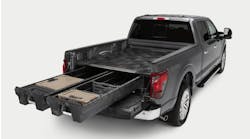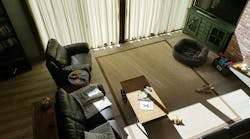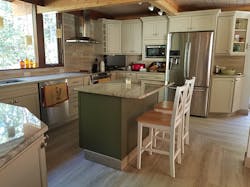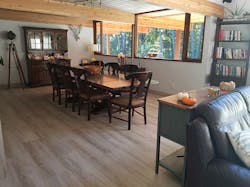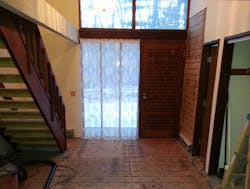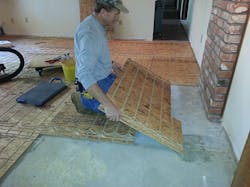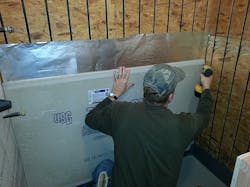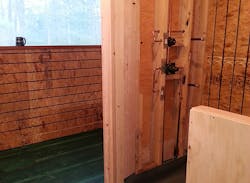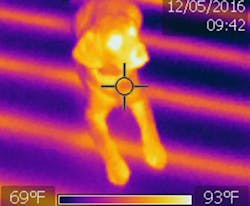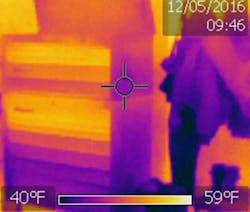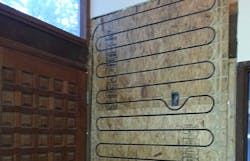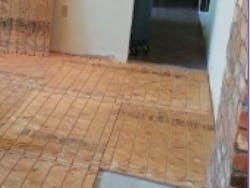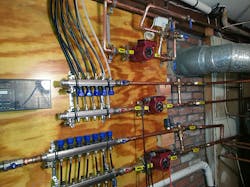Latest from Hydronics & Radiant
Sponsored
The Client: 1979 Deckhouse Post & Beam Structure, Slab on Grade
The Location: Massachusetts
The Size: 2,500-sq.ft. total
The Original Heating System: 350 lineal feet of hydronic copper fin tube radiation
The Heat Source: 1979 Burnham atmospheric natural gas fired boiler
This is a great story of salvaging and modernizing a structurally sound 37-year-old residential home. Besides dramatically improving the heating comfort for the occupants, the transformation of the living space, working with exactly the same building footprint, was remarkable. By eliminating the total 350 lineal feet of copper fin tube baseboard radiation and 20 feet of floor trough convectors in front of a window wall, we physically increased the usable floor space by 350 square feet.
Interior design flexibility
But more importantly, the achieved interior design flexibility is the amazing end result. Not having to lay out the room's furnishings and appliances around unsightly sheet metal convectors with their proper clearance for air circulation, not to mention the black dust streaking on the walls and furnishings, and burnt dust smells and noisy expansion ticking caused by the copper piping.
Poorly insulated
Our client is a voluminous home with 20-ft. high ceilings and lots of glass, R14 four inch exterior walls and R16 T+G decking and 2-in. of rigid foam board in the roof ceilings (no attic). All building standards from the 70s and 80s, i.e., not an easy house to heat under New England winter conditions. This constitutes no problem with a radiant system where the air infiltration factor is reduced dramatically and subsequently the heat loss of the building.
Floor elevation
Here is how we overcame the challenge of floor elevations due to the radiant panel build up, both on the first and second floor of the structure. Remember, we are dealing with a structure build on a concrete slab (first floor) and 2 1/2" T+G decking over, post and beam frame on the second floor.First floor
By removing wall-to-wall plush carpeting, including the padding from the slab, we achieved an inch in floor height reduction. Enough for our radiant panel system Uni-Panels ½-in. in thickness, plus mastic (Superflex) and ceramic tile ½-in. in thickness. No increase in floor finish height, eliminating door threshold issues.
Second floor
By removing wall-to-wall carpeting, plus padding, in the bedrooms and stripping the tiles and plywood in the bathrooms and laundry down to the decking, we again gained 1 inch for our new radiant floor system, enough for our shallow 1/2" QuikTrak radiant panel plus floating oak flooring in the bedrooms and cement board plus ceramic tile in the bathrooms.
Due to the shallow ½-in. radiant panel systems, Uni-Panels over concrete slabs downstairs and QuikTrak over wood frame construction upstairs, we were able to retrofit radiant systems into an old existing building, which would normally not be possible. Without any increase in floor height, subsequently maintaining the ceiling height and not interfering with interior and exterior door thresholds as well as exterior sliding patio door panels. Otherwise a structural alteration challenge of impossibility.
How to provide supply and return piping to distribution manifolds for the radiant tubing from the existing boiler room to the first and second floor manifold locations. Remember, no crawl space or basement to snake Pex tubing through and up the walls. The obvious solution guess what? Utilize the existing ¾-in. copper lines originally supplying the fin tube convectors.
Two out of the old four baseboard zones were suitable to be utilized for radiant manifold supplies, which made life a lot easier, not having to jack hammer slots into the concrete slab to bury Pex tubing. The rest of the radiant floor circuits we were able to route back from the floor directly to the boiler room, located between the garage and the living room, mounting the manifolds next to the boiler.
Another option to route Pex supply lines above the concrete slab are hollow baseboard sections to recessed wall manifolds.
The garage was unheated. We simply added a hydronic unit heater and one wall of radiant wall heating "Uni-Panels." All piped back to the adjacent existing boiler room.
High heat loss areas
Other radiant wall Uni-Panels were utilized in two bathrooms upstairs under windows and in shower stalls as well as in a high heat loss sitting area off the kitchen and in the entry to radiant wash a large glass area. A guest bath downstairs also needed some wall heating compensation, i.e. basically all areas which traditionally don't have enough floor area to heat the room sufficiently under design conditions.
Uni-Panel attachment method to the concrete slab
The most cost and labor effective installation method has proven to be gluing and nailing the panels to the slab. Use Loctite high strength construction adhesive on the bottom membrane side of the panel. Lay down three or four panels at a time, then hammer drill 10 to 12 1/8-in. holes through the panel into the slab 11/2-in. deep. Drive 11/4-in. fluted, hardened concrete nails into the holes.
Shooting concrete nails does not work, uncontrollably breaking the slab at the penetration point with nails protruding. Old slabs are unpredictably hard and brittle. Not to mention the prohibitive cost of the cartridges and nails, using a concrete nail gun.
The above outlined method is quick, safe and very cost effective. The bonding effect to the slab is amazing. After 24 to 48 hours your radiant system is ready to be covered with ceramic tiles (no cement board required!!) or floating hardwood flooring and carpeting. When using tiles, use Superflex bonding mastic directly over the Uni-Panels and tubing. Any other flooring use aluminum sheeting supplied with the Uni-Panels, applying it with 3M spray Adhesive one section at a time as finished floor goes down.
Faster than you can blink an eye
With the system being in operation the third winter, the most amazing benefit, if you know something about the reaction time of various types of radiant systems and their one common shortcoming, is its reaction time and controllability. You won't have enough time to take your socks off, from turning your thermostat up from a cold start to walking barefooted over the tile floor, feeling the heat with your happy toes putting on a smile.
After literally 10 minutes your radiant slab is in full BTU output mode, pumping away into the living space. It's a superfast responding system, you wouldn't believe. Uni-Panels can be used for walls, ceilings, slab overlays, basement remodeling, ice dam prevention and solar collectors.
Joe Fiedrich is a former hydronic heating columnist for CONTRACTOR. He was the president of Stadler Corp., which is now part of Viega North America, and he is the inventor of the Viega Climate Panel and Uponor Quik Trak. He can be reached at [email protected]. Also, visit his company Hydronics Manufacturing.
